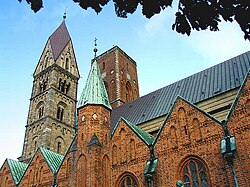Diocese of Ribe Ribe Stift | |
|---|---|
 The Cathedral of the diocese. | |
 Coat of arms | |
| Location | |
| Country | Denmark |
| Statistics | |
Population
|
|
| Members | 295,860 (83.1%) |
| Information | |
| Denomination | Church of Denmark |
| Cathedral | Our Lady Cathedral of Ribe |
| Current leadership | |
| Bishop | Elof Westergaard |
The Diocese of Ribe (Danish: Ribe Stift) is a diocese within the Church of Denmark. Ribe Cathedral serves as the central cathedral within the diocese. Since 2014, the bishop has been Elof Westergaard. [1] [2]
Contents
The former Roman Catholic Diocese of Ribe was formed in 948 and oversaw much of southern Jutland. During the Protestant Reformation, the diocese converted to Lutheranism alongside the formation of the Church of Denmark. [3] Thus, the diocese in its current form was established in 1536.
As of 2020, the diocese oversees 219 individual churches in 200 sogns, which are divided among 8 deaneries. The diocese covers a region with a population of 355,839, of which 295,860 are members of the church. [4]